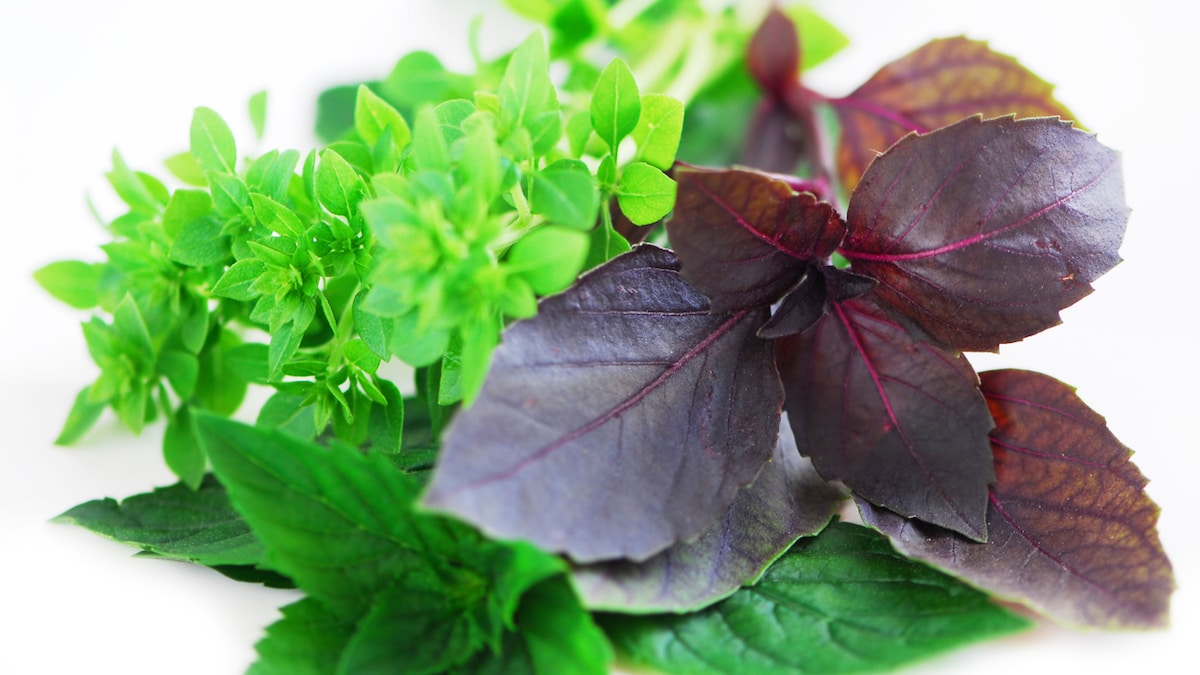Pesto sauce, tulsi tea, Thai soup—basil is used in many culinary creations, but we’re not quite sure whether we should use holy basil from the plant we have at home or get the other variety, known as sweet basil. I love the flavor of basil in my food, but when I cook, I often get confused about which one to choose. Do you feel the same way? First, let’s get this fact out of the way: basil and holy basil are similar, but not the same! While these two are versatile herbs, they have unique flavors and culinary uses. Understanding their differences can help you make informed decisions and allow you to get better flavor in your meals.
Read also: 9 Amazing Benefits of Basil Leaves You Might Not Know
Basil vs Holy Basil: Botanical Differences
Basil (Ocimum basilicum) and holy basil (Ocimum sanctum) belong to the same genus but different species. The common type of basil comes in different varieties that can range from bright green leaves to those with a violet hue. They have a sweet and spicy flavor. Holy basil, also known as tulsi, has smaller green leaves with violet veins and has a stronger, more pungent aroma and flavor.
Basil vs. Holy Basil: Different Culinary Uses
Uses of basil in the kitchen:
- Italian Cuisine: Basil is a staple herb used in Italian cooking to make pesto, marinara sauce, and caprese salad. Its fresh, bright flavor pairs perfectly with tomatoes, garlic, and olive oil.
- Mediterranean Dishes: Well, the origin of basil reflects its use in Mediterranean cuisine and especially the flavor it adds to Greek salads and grilled vegetables. Some of the many Thai dishes that use basil include pad thai and green curry, among others. Basil adds a fragrant and herbaceous note to these tasty dishes.
Uses of holy basil in the kitchen:
- Indian Cuisine: Holy basil is considered a sacred herb in Hinduism and is widely used in Indian cuisine for its distinctive spicy and slightly bitter flavour in curries, soups and stir-fry dishes.
- Thai cuisine: It is also used in Thai cuisine, mainly in green curry and pad ka prao (stir-fried basil).
- Ayurvedic Medicine: Holy basil is a very important plant in Ayurveda, highly praised for its medicinal properties and its uses in curing various diseases.
Read also: 7 delicious recipes to include basil in your daily diet
Basil is used in many culinary preparations.
Photo credit: iStock
Basil vs Holy Basil: Flavor Profiles
Basil has a sweet flavor with a bright, slightly spicy edge. It pairs well with tomatoes, garlic, and other Mediterranean ingredients. Holy basil, on the other hand, has a sharp, peppery flavor with a hint of camphor. The depth and complexity it brings to a dish is unique, especially in those that have spicy or earthy tones.
Health benefits of basil:
Basil and holy basil have several similar health benefits. The former contains antioxidants and is therefore associated with its health benefits such as improving digestion and reducing inflammation for optimal cognitive function. Holy basil is so named probably because of its revered position in Ayurveda as a medicine. It is supposed to be an adaptogen, meaning it helps the body deal with stress.
Cultivation and harvesting
Sweet basil and holy basil are relatively easy to grow in gardens or containers. They prefer warm, sunny conditions and well-drained soil. Regular harvesting will encourage bushier growth and prevent the plants from flowering too early.
Basil vs. Holy Basil: Can They Be Used Interchangeably?
Basil and holy basil have very unique characteristic flavours and are best suited for the type of recipes they are intended for. They can, however, be substituted for each other, but how you do this will depend solely on the dish you are preparing and the emphasis on flavour you wish to bring out. I have used holy basil for cooking pasta and even pesto sauceThe dishes didn’t have the same flavor but it wasn’t a bad idea.
Whether you want a classic Italian flavour or an exotic Indian twist, these herbs will help you enhance your dishes and create a memorable meal.
Disclaimer:
The information contained in this post is for general information purposes only. We make no representations or warranties of any kind, express or implied, about the completeness, accuracy, reliability, suitability or availability with respect to the website or the information, products, services, or related graphics contained on the post for any purpose.
We respect the intellectual property rights of content creators. If you are the owner of any material featured on our website and have concerns about its use, please contact us. We are committed to addressing any copyright issues promptly and will remove any material within 2 days of receiving a request from the rightful owner.

